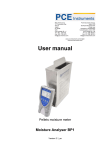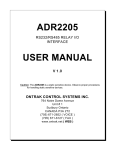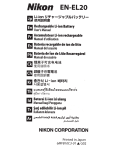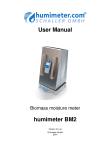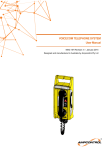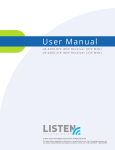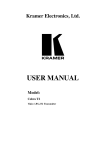Download PDF - Yeti 150
Transcript
TABLE OF CONTENTS We’d like to officially welcome you to the GZ Nation. This is a family dedicated to changing the world, one person at a time. Share your stories, get involved and show us what you’ve got at GoalZero.com Getting Started 2 i. Get to Know Your YETI ii. Unpacking Your YETI iii. What it Powers Charging your YETI 4 i. Charging from Solar ii. Charging from the Wall iii. Charging from the Car Using your YETI 6 i. What can I Power? ii. How to Use iii. Best-Use Strategy iv. Cold Weather Usage v. Storage and Downtime Maintenance Technical Specifications 7 Frequently Asked Questions 8 Troubleshooting 11 Education 12 i. Batteries 101 ii. Solar 101 Warranty and Contact Info 14 Congrats on your new Goal Zero YETI 150 Solar Generator, a plug-and-play generator for emergencies, camping, or wherever you need power. With 150 watt-hours of power, you can keep laptops, smartphones, lights and more going for hours longer. Make sure you go online and register your product to activate your warranty. You’ll also be able to sign up to receive notifications and alerts regarding the YETI. www.GoalZero.com/warranty CHARGE ME NOW: Before reading through the rest of the manual, plug your YETI into the wall. You should store your YETI plugged in, so the battery is always healthy and full. 1 Get To Know Your Gear INPUT Charging Port Charging Indicator Light LCD Battery Display Individual Port Power Buttons OUTPUT AC Outlets (modified-sine wave) USB Outputs 12V 6mm Port 12V Car Port Unpacking your YETI A AC Wall Charger (2 pieces) B Goal Zero Yeti 150 Solar Generator C Legacy-Nomad Adapter (4.7 to 8mm) A What it Powers B C 2 LAL Smartphone TABLET LAPTOP 50 Hours 15 Recharges 6 Recharges 2 Rercharges See page 10 for more details. 3 Charging Your YETI GOAL ZERO YETI 150 Solar Generator LAPTOP CHARGE ME NOW: Before using or storing, plug your YETI into the wall until it is fully charged. If at any point you hear a beeping from your YETI, plug it into a power source, like an AC outlet or a solar panel, as soon as possible. This built-in warning indicator is to help prevent battery damage when the charge gets low. For more tips and tricks on keeping your battery healthy, see the BATTERY 101 section. LCD Battery Display: The LCD Battery Display indicates the charge level of your YETI. There are 5 segments to the battery, approximating 20% - 40% - 60% - 80% 6 Hours 2 Recharges Charging from the Wall -100% capacity. As you use your YETI, segments will disappear from the display, Using the included AC Wall Charger, plug your YETI into any wall outlet. You will know indicating the remaining charge. When charging your YETI you will notice a battery the Yeti is charging when the blue LED light next to the INPUT port turns on, and segment blinking at a 1 second interval. This indicates the current charge status. battery segments in the BATTERY DISPLAY are blinking. The YETI is fully charged Once your YETI is fully charged, all battery segments will be lit and remain solid. when all battery segments stop blinking and remain solid. The YETI should recharge NOMAD 20 Solar Panel GOAL ZERO YETI 150 Solar Generator LAPTOP from the wall in about 6 hours. 1. The AC wall charger comes in two pieces. Connect the two pieces by plugging the cable into the box 17 Hours Full Sun 2 Recharges Charging from Solar 1. Place your solar panel where it will get as much direct sunlight as possible. See the graphic in the SOLAR 101 section for help. 2. Insert the blue-ringed plug into the INPUT port on the front of the YETI. You will know the YETI is charging when the blue LED light next to Charging from your Car Although not recommended because of slow charge times, you can charge your YETI from any 12V source, like your car. To charge your YETI from a car or 12V source, you will need to purchase an 8.0 mm to 12V charger from GOALZERO.com. Call our Customer Solutions Center at 1-888-794-6250 for help identifying the charger. the INPUT port lights up, and the battery segments in the LCD BATTERY DISPLAY are blinking. The YETI is fully charged when all battery segments stop blinking and remain solid. 3. Your YETI is capable of taking in up to 60W of solar power. Some GOAL ZERO panels are chainable to provide more power to your YETI and reduce solar charge times. When connecting older versions of the NOMAD and BOULDER Solar Panels, use the Legacy-Nomad Adapter Cable to connect to the YETI. 4 5 Using your YETI What to power from your YETI: USB: Smartphones, MP3 Players, Digital Cameras, E-readers, Tablets, etc. 12V: Goal Zero Lights, Car adapters, etc. AC: Laptops, Cameras, CPAP, Display Monitors, etc. How to use your YETI: 1. Press the power button located above each port you will be using. 2. You’ll know the port is turned on when the green LED light on the button is illuminated. Technical Specifications Charge times Wall charger (72W) 6 hrs Car charger (30W) 8 hrs GOAL ZERO Nomad 13 26-52 hrs GOAL ZERO Nomad 20 17-34 hrs GOAL ZERO Boulder 15 22-44 hrs Battery 3. Plug in your gear for power anywhere life takes you. Cell type AGM Lead Acid 4. Keep your YETI plugged into a power source when not in use. Pack capacity 168Wh (12V, 14Ah) Lifecycles hundreds of cycles Shelf-life Keep plugged in or charge every 3 months Fuses 20A, user replaceable fuse Management system Charging and low-battery protection built-in Best-Use Strategy: When recharging gear with your YETI, take note of the LCD Battery Display. If you plug in devices that have a high power requirement (a state-of-the-art gaming laptop), the charge level of your YETI can drop very quickly and you may not get exactly 150Wh of power. On the flipside, if you’re recharging devices that draw power more slowly (a tablet), you will get closer to 150Wh from your YETI. If you’re experiencing shorter runtimes, you may want to Ports check the device’s power requirements, see TROUBLESHOOTING section USB port (output) 5V, up to 2.1A (10W max), regulated 6mm port (output, 6mm, green, hexagon) 12V, up to 10A (120W max) 12V car port (output) 12V, up to 10A (120W max) AC inverter US (output, 60Hz, modified sine wave) 110V, 0.7A (80W continuous, 160W surge max) International AC inverter (output, 50Hz, modified sine wave) 220V, 0.4A (80W continuous, 160W surge max) charging port (input, 8mm, blue, circle) 14-29V, up to 5A (60W max) for help. Cold Weather Usage: Cold temperatures (below freezing) can impact the YETI’s battery capacity. If you’ll be living off-grid in sub-zero conditions, we recommend keeping your YETI in an insulated cooler, and connected to a power source (solar panels). The natural heat generated by the YETI contained in an insulated cooler will keep battery capacity at its highest. Storage and Downtime Maintenance: Having your YETI connected to a power source, like a solar panel or wall outlet, between adventures or while in storage keeps its battery healthy and topped off. This prolongs battery life and will ensure your YETI is charged and ready to go all day, every day. If you can’t keep your YETI plugged into a power source during storage, fullycharge your YETI every 3 months and store it in a cool, dry place. Failure to maintain your YETI by following these steps can result in battery damage which will void the product warranty. 6 General Chainable no Weight 12 lbs (5.4 kg) Dimensions 7.75 x 5.75 x 6.75 in (19.7 x 14.6 x 17.2 cm) Operating usage temp. 32-104 F (0-40 C) Certs CE, FCC, ROHS Warranty 6 months 7 Frequently Asked Questions What type of battery is in my YETI? Your YETI uses a 12V sealed lead-acid battery (AGM), similar to what is found in your car. Here are some basic facts about AGM batteries: 1. AGM batteries should be kept full at all times. This means you should leave your YETI plugged into a power sources at all times, especially during storage. 2. AGM batteries last longer if you do not drain them completely. This stems from the “battery memory myth” in old rechargeable batteries. You can read more about this in the Battery 101 section on page 12. How do I know if my YETI is charged? To check the charge level of your YETI, refer to the LCD Battery Display. When lit up, you’ll see a battery outline with 5 segments, indicating the current charge level. You can turn on the Battery Display by pushing one of the power buttons above each output port. It is OK to use your YETI even when it’s not fully charged. My YETI is beeping… what does that mean? 6. Reattach RED and BLACK battery connections. 7. Reattach the top of the YETI to its base. Once you have replaced your battery, you will need to find a local battery recycling center to dispose of it properly. For more help replacing your YETI’s battery, contact our Customer Solutions Center at 1-888-794-6250 or at [email protected] One of the green LED lights on the Output Port buttons turned red… what does that mean? You have tripped the over current protection inside the YETI, which usually means your device has pulled too much power. Reset the breaker by pushing the Output Port button twice. If this continues to happen, check and make sure your device is suitable for use with the YETI, then give our Customer Solutions center a call. How do I know if my device will work with the YETI? First, you’ll need to determine the amount of power your device requires. This may require some research on your end, a good online search or reading the user guide for your device should suffice. Second, you will need to check the capacity for the individual output ports. Plug your YETI into a power source, like a solar panel or outlet, as soon as For example, the AC port is monitored by an inverter that allows for 80W of possible. This chirping is to alert you that your YETI’s battery is low and continuous power. This means if your device is a pulling more than 80W for needs to be charged. an extended period of time, the YETI’s inverter will shut off. The YETI’s 12V Can I take my YETI on a plane? You sure can. The YETI contains an advanced, sealed lead-acid battery that is completely safe to bring along on your flight. Bring along your user manual to show the type of battery inside. Is the battery inside my YETI replaceable? Your YETI depends on an advanced lead-acid battery to power your gear, ports allow for 120W of power and might be a better solution if your device is pulling more power than the AC inverter can handle. Once you know your device is compatible, you’ll want to determine how long you’ll be able to power your gear from the YETI. How long will the YETI run my device? Here’s a quick and dirty lesson in power: and like all other batteries, one day it will make the journey to the battery All GOAL ZERO rechargers have a number in their name, ex. GUIDE 10 Plus graveyard. Lucky for you, the YETI’s battery is replaceable. Follow these Recharger, GOAL ZERO YETI 150 Solar Generator. These numbers refer steps for replacing your YETI’s battery: to the Watt Hours (Wh), or the amount of energy that can be stored in each 1. Disconnect all cables and cords from the YETI. 2. Unscrew the four bolts attaching the top of the YETI to its body and lift off. battery, and how you’ll know if your gear is compatible with each recharger. For example, a 200Wh battery should run a 100W light for 2 hours (200/100=2). If your gear falls within the 150Wh capacity of the YETI, you’ll want to check the restrictions on each of the output ports. 3. Locate the RED and BLACK battery connections. 4. Pull back lightly in each connector. 5. Install the new battery by carefully setting it inside the YETI. 8 9 Here are some common devices and their watt-hour requirements: Device Power from Yeti 150 Light-a-Life 12V Lantern (3Wh) 50 Hrs Smartphone (5-7Wh) 15 Recharges Tablet (25-42Wh) 3-6 Recharges Digital Camera (8Wh) 12 Recharges DVD Player (20-25W) 6-7 Hrs Laptop (50W) 1-7.5 Hrs Radio/Stereo (40W) 3 Hrs Troubleshooting If your devices are not charging from your YETI, follow these steps: 1. Ensure the Output Port has been turned on. The green LED light on the power button should be lit up. 2. Check the Battery Display. If it is at 20% or below, recharge your YETI. 3. Verify your device is suitable for use with the YETI: a. All of the YETI output ports have their own max power capacity. Check the YETI’s Tech Specs to ensure your device is compatible. So when you’re deciding on what to power from your new GOAL ZERO b. Some devices, like laptops and tablets, with rechargeable batteries recharger, do some research into your device’s wattage consumption. For more may pull more watts when in use. In these cases, power down your device quick tips and learning tools, check out www.GOALZERO.com/learn.html and recharge it. Disclaimer for modified-sine wave inverter used in the Goal Zero YETI 150 Solar Generator: 4. Try resetting the YETI: **Do not charge the YETI or attempt to recharge devices while Modified-sine wave inverters, like those used in the YETI 150, are the most resetting the YETI battery. common inverters on the market. They work great with small electronic a. Disconnect all cables and cords from the YETI. equipment, usually anything that includes an AC power cable with the box, like what your laptop comes with. Products that are suitable to use with your YETI 150 include: Electronic devices such as laptops, phone chargers, cameras, etc Electrical equipment including lights, TVs, CPAP, etc Avoid these devices with your YETI 150. Some or all of the following devices are not suitable for use with a modified sine wave inverter and should not be used with the YETI 150. Any such use is entirely at the owner’s risk and GOAL ZERO does not accept any b. Unscrew the 4 bolts attaching the top of the YETI to its body and lift off. c. Locate the RED and BLACK battery connections. d. Slide one of the connectors back by pulling lightly on the cable. e. Wait 5 seconds and reconnect the cables. It’s normal to see a small spark when reconnecting. f. Reattach the top of the YETI to its base. If you are still experiencing trouble with your YETI, please call our Customer Solutions Center at 1-888-794-6250 or by email at [email protected] responsibility for damage or injury resulting from such use: Fluorescent lights with dimming function Power tools employing “solid state” power or variable speed control Digital clocks with radios Sewing machines with speed control 10 11 Education BATTERIES 101: GOAL ZERO utilizes the latest and greatest in battery technology to accompany you on all life’s adventures. From the versatile and lightweight Lithium Ion, to the robust and powerful Lead Acid, we’ve compiled some helpful tips to keep your GOAL ZERO batteries working their best. i. Batteries need exercise – we didn’t invent solar power, we perfected it. Some things to keep in mind when recharging your gear with solar power: i. Solar panels don’t store power from the sun, they collect it. We teach you to COLLECT – STORE – USE, which is the best way to utilize solar power to recharge your gear. COLLECT the sun’s energy with a solar panel. STORE the power in a recharger. USE the recharger to power your The best thing for any battery is to use it. Don’t leave a charged battery gear, day or night. If you’re really a diehard, you can plug your gear directly sitting around, unloved and unused for long periods of time. into the junction box located on the back of our NOMAD Solar Panels to ii. The “Battery Memory” myth recharge from the sun. Thanks to old Nickel-Cadmium (NiCd) batteries, there’s a myth running ii. Not all solar charge times are created equal around that you should completely drain your batteries before plugging Most solar panel manufacturers calculate their recharge times with the them in for a recharge, called “deep cycling”. Although true with NiCd following equation: Device Watt Hours/Solar Panel Watts = Solar Recharge batteries, the typical batteries you’ll find in most of your gear today, Times. So theoretically, a 13 watt solar panel would recharge a 50 watt- including the advanced lithium and lead-acid batteries used in your GOAL hour recharger in 3.84 hours (50/13 = 3.84) – and this is the number you ZERO products, require no such draining. In fact, you should avoid deep could find in marketing material for a solar panel. However, in order to cycling your batteries – it does more harm than good in most cases. standardize results across all manufacturers, these tests are completed iii. The “Stadium Effect” in laboratory settings.. The truth is, on a good, sunny day, you’ll receive The stadium effect occurs when recharging your batteries. You’ll notice your battery quickly filling up in the beginning, then slowing down noticeably when trying to charge up the last several percentages. Think about 50-75% of your solar panel’s rated wattage, and this is how the engineers at GOAL ZERO calculate the solar recharge times you see on our packaging. of how quickly a stadium fills up when the doors first open – there are iii. Solar works, even in overcast conditions. hundreds of open seats so it’s easy to find the one you want. Eventually Solar panels utilize IR, UV, and visible rays from the sun that can penetrate there are only a few open seats here and there and people have to through clouds. Although the efficiency of the solar panel will decrease in maneuver around to find the spot they want and filling those seats takes cloudy conditions, you’ll still be collecting valuable power from the sun. longer. The same theory applies to recharging batteries. It’s easy for energy to flow in and take up empty space in the beginning, and as time goes on and there is less space available, it takes longer for the energy to fill in the holes. iv. Read the manual. Yeah, it might be a long read, but the manual is the best place to find the dos and don’ts for the battery in your specific device. Reading your manual will ensure you’re taking steps to keep your batteries happy and healthy. 12 SOLAR 101: GOAL ZERO makes it easy to recharge your gear from the sun iv. Keep away from shade and windows. Although you should seek out the shade on sunny days, your solar panels will collect more power when fully exposed to the sunlight. Windows also have a habit of decreasing efficiency. So keep those panels outside and in the bright sunlight. v. Proper alignment works wonders. Keeping your solar panel angled toward the sun can dramatically increase solar efficiency. Set it up and let Mother Nature do the rest. 13 Warranty & Contact LIMITED WARRANTY GOAL ZERO LLC warrants to the original consumer purchaser that this GOAL ZERO product will be free from defects in workmanship and material under normal consumer use during the applicable warranty period identified in Paragraph 2, below, subject to the exclusions set forth in Paragraph 5, below. This warranty statement sets forth GOAL ZERO’s total and exclusive warranty obligation. We will not assume, nor authorize any person to assume for us, any other liability in connection with the sales of our products. WARRANTY PERIOD The warranty period for GOAL ZERO battery cells (whether purchased on a stand-alone basis or as part of another product) is 180 days. The warranty period for all other GOAL ZERO products and components is one (1) year. In each case, the warranty period is measured starting on the date of purchase by the original consumer purchaser. The sales receipt from the first consumer purchase, or other reasonable documentary proof, is required in order to establish the start date of the warranty period. If you completed the online GOAL ZERO Product Registration Form within 30 days after purchasing your product, that registration can also establish the start date of the warranty period (but warranty coverage is not conditioned upon such registration). REMEDY GOAL ZERO will repair or replace (at GOAL ZERO’s option and expense) any GOAL ZERO product that fails to operate during the applicable warranty period due to a defect in workmanship or material. LIMITED TO ORIGINAL CONSUMER BUYER The warranty on GOAL ZERO’s products is limited to the original consumer purchaser and is not transferable to any subsequent owner. EXCLUSIONS GOAL ZERO’s warranty does not apply to (i) any product that is misused, abused, modified, damaged by accident, or used for anything other than normal consumer use as authorized in GOAL ZERO’s then-current product literature, or (ii) any product purchased through an online auction house. GOAL ZERO’s warranty does not apply to any battery cell or product containing a battery cell unless the battery cell is fully charged by you within seven (7) days after you purchase the product and at least once every 6 months thereafter. HOW TO RECEIVE SERVICE To obtain warranty service, you must contact our customer service team via telephone at (888) 794-6250, or via email at [email protected]. If our customer service team determines that further assistance is required, they will give you a Return Material Authorization (“RMA”) number and will provide you with prepaid return shipping label that you can use to mail back your nonfunctioning item(s). You must properly package the product, clearly marking the RMA number on the package and including proof of your purchase date with the product. We will process your return and send your repaired or replacement product to you at our expense for product being shipped to locations in North America. For product purchased or being shipped outside of North America, please contact the local distributor from whom you purchased the product or email support@ goalzero.com to obtain further distributor information. IMPLIED WARRANTIES THE LIMITED WARRANTY STATED HEREIN IS IN LIEU OF ALL OTHER EXPRESS WARRANTIES. IN NO EVENT SHALL ANY IMPLIED WARRANTIES, INCLUDING BUT NOT LIMITED TO ANY WARRANTIES OF MERCHANTABILITY, FITNESS FOR A PARTICULAR PURPOSE OR NONINFRINGEMENT, EXTEND BEYOND THE APPLICABLE WARRANTY PERIOD IDENTIFIED IN PARAGRAPH 2, ABOVE. Some states do not allow limitations on how long an implied warranty lasts, so the above limitation may not apply to you. This warranty gives you specific legal rights, and you may also have other rights which vary from state to state. EXCLUSIVE REMEDY; LIMITATION OF LIABILITY The foregoing provisions state GOAL ZERO’s entire liability, and your exclusive remedy, for any breach of warranty, express or implied. IN NO EVENT WILL GOAL ZERO BE LIABLE FOR ANY CONSEQUENTIAL OR INCIDENTAL DAMAGES ARISING FROM ANY USE OR MALFUNCTION OF ANY GOAL ZERO PRODUCT, OR FROM ANY BREACH OF WARRANTY, INCLUDING DAMAGE TO OTHER DEVICES. IN NO EVENT WILL GOAL ZERO’s LIABILITY FOR ANY CLAIM, WHETHER IN CONTRACT, WARRANTY, TORT (INCLUDING NEGLIGENCE AND STRICT LIABILITY) OR UNDER ANY OTHER THEORY OF LIABILITY, EXCEED THE AMOUNT PAID BY YOU FOR THE GOAL ZERO PRODUCT. Some states do not allow the exclusion or limitation of incidental or consequential damages, so the above limitation or exclusion may not apply to you. Toll Free: 888.794.6250 675 West 14600 South Bluffdale, UT 84065 14 We proudly support TIFIE Humanitarian www.tifie.org


















